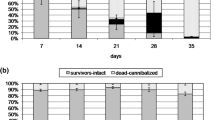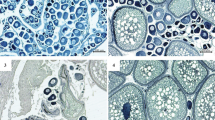Summary
Specimens of Porcellio scaber taken from a stable culture and placed into glass dishes where they are fed leaf litter will lose copper through their faeces until the latter have accumulated sufficiently to form a thin layer of substrate. Under the experimental conditions chosen the animals show a net loss of copper for about three days. The copper content of the faecal substrate increases until the metal can be picked up again by the animals recycling their own faeces. After about a week the copper content of the faeces in the dish has dropped to a level comparable to that of the substrate in the original culture. Synchronous with this cycle of loss and gain the copper is transported between the two main body compartments: hepatopancreas and blood plus integument. At the beginning of the experiment two-thirds of the metal are stored in the hepatopancreas, but within one day the situation is reversed and two-thirds of the total body copper will be found outside the hepatopancreas. This condition lasts until about the third day of the experiment after which the original distribution is gradually resumed. In starving animals no such changes in the distribution of copper take place. On the other hand, a similar reversal can be found in females during the breeding period when copper leaves the hepatopancreas until about two-thirds of the total body copper are located outside this organ. Embryos and juveniles taken from the marsupium have a relatively high copper content, but it is not high enough to account fully for the increase in non-hepatopancreas copper.
The dramatic movements of copper between the main body compartments are interpreted as being part of a complex mechanism that minimizes the loss of this important element during periods of high metabolic activity of the hepatopancreas.
Similar content being viewed by others
Literatur
Manwell, C., and C. M. Baker: Starch gel electrophoresis of sera from some marine arthropods: studies on the heterogeneity of hemocyanin and on a “ceruloplasmin-like pr protein”. Comp. Biochem. Physiol. 8, 193–208 (1963).
Pandian, T. J. (1967): Diskussionsbem. zu Wieser 1967 (s. u.)
Weischer, M. L.: Stoffwechselphysiologische Untersuchungen zur Bedeutung des Haemocyanins bei Helix pomatia L. Zool. Beitr., N.F. 11, 517–540 (1965).
Wieser, W.: Untersuchungen über die Ernährung und den Gesamtstoffwechsel von Porcellio scaber (Crustacea: Isopoda). Pedobiol. 5, 304–331 (1965 a).
—: Über die Häutung von Porcellio scaber Latr. Zool. Anz. (Suppl. Bd.) 28, 178–195 (1965 b).
—: Die Steuerung von Stoffwechselvorgängen bei Porcellio scaber Latr. durch Temperatur und Licht. Zool. Anz. (Suppl.-Bd.) 28, 359–364 (1965 c).
—: Copper and the role of isopods in degradation of organic matter. Science 153, 67–69 (1966).
—: Conquering terra firma: The copper problem from the isopod's point of view. Helgol. Wiss. Meeresunters. 15, 282–293 (1967).
Zuckerkandl, E.: Hémocyanine et cuivre chez un crustacé décapode, dans leur rapports avec le cycle d'intermue. Ann. Inst. océanogr., Monaco 38, 1–122 (1960).
Author information
Authors and Affiliations
Rights and permissions
About this article
Cite this article
Wieser, W., Wiest, L. Ökologische Aspekte des Kupferstoffwechsels terrestrischer Isopoden. Oecologia 1, 38–48 (1968). https://doi.org/10.1007/BF00377253
Received:
Issue Date:
DOI: https://doi.org/10.1007/BF00377253




